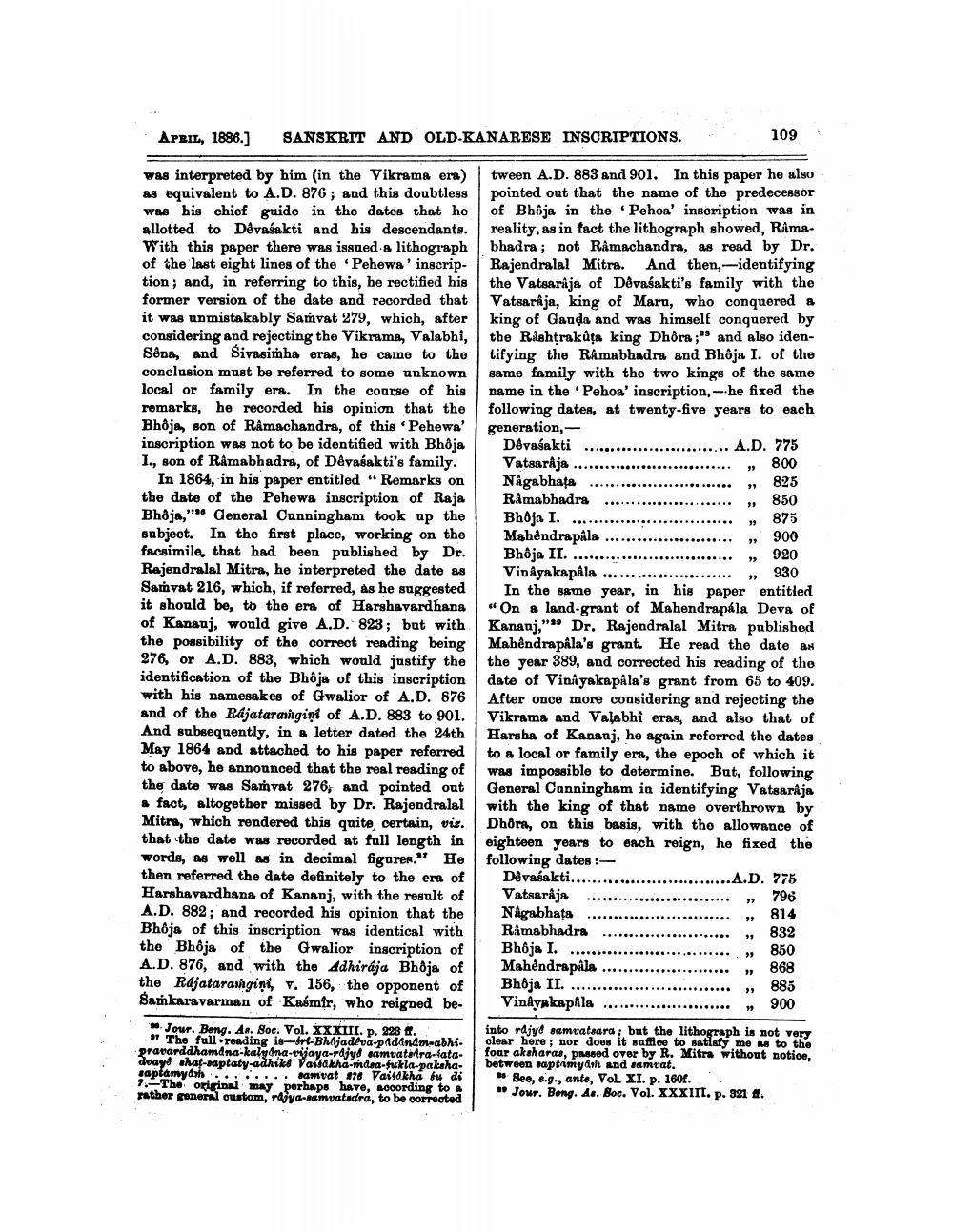________________
APRIL, 1886.]
was interpreted by him (in the Vikrama era) as equivalent to A.D. 876; and this doubtless was his chief guide in the dates that he allotted to Dêvasakti and his descendants. With this paper there was issued a lithograph of the last eight lines of the 'Pehewa' inscription; and, in referring to this, he rectified his former version of the date and recorded that it was unmistakably Samvat 279, which, after considering and rejecting the Vikrama, Valabhi, Sêna, and Śivasimha eras, he came to the conclusion must be referred to some unknown local or family era. In the course of his remarks, he recorded his opinion that the Bhôja, son of Ramachandra, of this 'Pehewa' inscription was not to be identified with Bhôja I., son of Râmabhadra, of Devasakti's family.
In 1864, in his paper entitled "Remarks on the date of the Pehewa inscription of Raja Bhôja," General Cunningham took up the subject. In the first place, working on the facsimile, that had been published by Dr. Rajendralal Mitra, he interpreted the date as Samvat 216, which, if referred, as he suggested it should be, to the era of Harshavardhana of Kanauj, would give A.D. 823; but with the possibility of the correct reading being 276, or A.D. 883, which would justify the identification of the Bhôja of this inscription with his namesakes of Gwalior of A.D. 876 and of the Rájatarangini of A.D. 883 to 901. And subsequently, in a letter dated the 24th May 1864 and attached to his paper referred to above, he announced that the real reading of the date was Samvat 276, and pointed out a fact, altogether missed by Dr. Rajendralal Mitra, which rendered this quite certain, viz. that the date was recorded at full length in words, as well as in decimal figures." He then referred the date definitely to the era of Harshavardhana of Kanauj, with the result of A.D. 882; and recorded his opinion that the Bhôja of this inscription was identical with the Bhôja of the Gwalior inscription of A.D. 876, and with the Adhirája Bhoja of the Rajataragini, v. 156, the opponent of Samkaravarman of Kasmir, who reigned be
SANSKRIT AND OLD-KANARESE INSCRIPTIONS.
Jour. Beng. As. Soc. Vol. XXXIII. p. 223 ff. "The full reading is-ért-Bhejadeva-padinam-abhipravarddhamana-kalyana-vijaya-rdjyd samvatetra-lataavayê shat-saptaty-adhike Vaisakha-mdea-fukla-pakshasaptamyam........ samvat #76 Vais6kha bu di 7. The original may perhaps have, according to a rather general custom, rajya-samvatsara, to be corrected
tween A.D. 883 and 901. In this paper he also pointed out that the name of the predecessor of Bhôja in the 'Pehoa' inscription was in reality, as in fact the lithograph showed, Ramabhadra; not Ramachandra, as read by Dr. Rajendralal Mitra. And then,-identifying the Vatsaraja of Devasakti's family with the Vatsaraja, king of Maru, who conquered a king of Gauda and was himself conquered by the Rashtrakuta king Dhôra ;" and also identifying the Ramabhadra and Bhôja I. of the same family with the two kings of the same name in the 'Pehoa' inscription, --he fixed the following dates, at twenty-five years to each generation,Dôvasakti Vatsaraja.
********
Nagabhata Râmabhadra Bhôja I. Mahendrapala Bhôja II....... Vinayakapâla 930 In the same year, in his paper entitled "On a land-grant of Mahendrapála Deva of Kanauj," ," Dr. Rajendralal Mitra published Mahendrapâla's grant. He read the date as the year 389, and corrected his reading of the date of Vinayakapala's grant from 65 to 409. After once more considering and rejecting the Vikrama and Valabhî eras, and also that of Harsha of Kananj, he again referred the dates to a local or family era, the epoch of which it was impossible to determine. But, following General Canningham in identifying Vatsaraja with the king of that name overthrown by Dhôra, on this basis, with the allowance of eighteen years to each reign, he fixed the following dates :
Dêvasakti.. Vatsaraja
Nagabhaja Râmabhadra
Bhôja I. Mahendrapala Bhôja II.. Vinkyakapila
*******.
A.D. 775
800
39
31
39
99
39
39
...A.D. 775
796
814
832
850
868
885 "900
""
109
29
33
39
825
850
875
900
920
into rajyć samvatsara; but the lithograph is not very clear here; nor does it suffice to satisfy me as to the four aksharas, passed over by R. Mitra without notice, between saptamyash and samvat.
See, e.g., ante, Vol. XI. p. 160f.
Jour. Bong. Ae. Boc. Vol. XXXIII. p. 321 ff.




